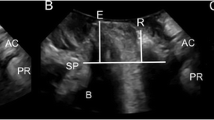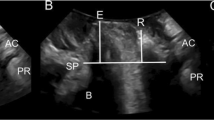Abstract
Background
The aim of this study was to demonstrate the distribution of defecographic pelvic floor abnormalities in constipated female patients and to correlate these dysfunctions with the mode of delivery.
Methods
Two hundred and fifty-five female patients who underwent defecography for constipation from 2001 to 2008 were reviewed and pelvic floor abnormalities were assessed. The patients were divided into three groups: group I had 50 nulliparous women, mean age 40.2 (±15.3), group II had 165 vaginally parous women, mean age 57 (±13.3), and group III had 40 patients delivered by cesarean section, mean age 50.6 (±11.9).
Results
Significant rectocele was identified in group I (36%), group II (35.8%), and group III (20%) without any statistically significant differences among the groups (p > 0.05). Intussusception was identified in group I (48%), group II (70.3%), and in group III (67.5%; p = 0.014). Intussusception associated with significant rectocele was more common in vaginally parous patients (p = 0.043). Abnormalities on puborectalis relaxation associated or not associated with rectocele were similar among the groups (p = 0.47). Vaginally parous patients had more abnormal exams as compared to other patients (p = 0.005). Significant rectocele was identified in (39%) patients with age ≥50 years and in (26.3%) patients with age <50 years (p = 0.03).
Conclusion
There was no specific correlation between distribution of pelvic floor disorders and mode of delivery in this study. Patients of age greater than 50 years had a higher incidence of significant rectocele.
Similar content being viewed by others
References
Allen RE, Hosker GL, Smith AR, Warrell DW (1990) Pelvic floor damage and childbirth: a neurophysiological study. Br J Obstet Gynaecol 97:770–779
Meyer S, Schreyer A, De Grandi P, Hohlfeld P (1998) The effects of birth on urinary continence mechanisms and other pelvic-floor characteristics. Obstet Gynecol 92:613–618
Peschers UM, Schaer GN, DeLancey JO, Schuessler B (1997) Levator ani function before and after childbirth. Br J Obstet Gynaecol 104:1004–1008
Chaliha C, Digesu A, Hutchings A, Soligo M, Khullar V (2004) Caesarean section is protective against stress urinary incontinence: an analysis of women with multiple deliveries. BJOG 111:754–755
Bernman L, Aversa J, Abir F, Longo WE (2005) Management of disorders of the posterior pelvic floor. Yale Biol Med 78:209–218
Ganeshan A, Anderson EM, Upponi S et al (2008) Imaging of obstructed defecation. Clin Radiol 63:18–26
Thompson W, Longstreth G, Drossman D, Heaton K, Irvine E, Muller-Lissner S (1999) Functional bowel disorders and functional abdominal pain. Gut 45(Suppl 2):II43–II47
Mahieu P, Pringot L, Bodart P (1984) Defecography: description of a new procedure and results in normal patients. Gastrointest Radiol 9:247–251
Mahieu P, Pringot J, Bodart P (1984) Defecography: contribution to the diagnosis of defecation disorders. Gastrointest Radiol 9:253–261
Stewart WF, Liberman JN, Sandler RS et al (1999) Epidemiology of constipation (EPOC) study in the United States: relation of clinical subtypes to sociodemographic features. Am J Gastroenterol 94:3530–3540
Watson SJ, Loder PB, Halligan S, Bartram CI, Kamm MA, Phillips RK (1996) Transperineal repair of symptomatic rectocele with Marlex mesh: a clinical, physiological and radiologic assessment of treatment. J Am Coll Surg 183:257–261
Gagliardi G, Pescatori M, Altomare DF et al (2008) Results, outcome predictors, and complications after stapled transanal rectal resection for obstructed defecation. Dis Colon Rectum 51:186–195
O’Connor JJ (2002) Dynamic imaging of pelvic floor with transperineal sonography. Tech Coloproctol. 6:59 (author reply)
Piloni V (2001) Dynamic imaging of pelvic floor with transperineal sonography. Tech Coloproctol 5:103–105
Karasick S, Spettell CM (1997) The role of parity and hysterectomy on the development of pelvic floor abnormalities revealed by defecography. AJR Am J Roentgenol 169:1555–1558
Brubaker L (1996) Rectocele. Curr Opin Obstet Gynecol 8:876–879
Olsen AL, Smith VJ, Bergstrom JO, Colling JC, Clark AL (1997) Epidemiology of surgically managed pelvic organ prolapse and urinary incontinence. Obstet Gynecol 89:501–506
Shorvon PJ, McHugh S, Diamant NE, Somers S, Stevenson GW (1989) Defecography in normal volunteers: results and implications. Gut 30:1737–1749
Arumungan PJ, Parel B, Rieck G et al (2004) Are obstetric risk factors and bowel symptoms associated with defaecographic and manometric abnormalities in women awaiting hysterectomy? J Obstet Gynaecol 24:274–278
Soares F, Regadas FS, Murad-Regadas SM, et al (2008) Role of age, bowel function and parity on anorectocele pathogenesis according to cinedefecography and anal manometry evaluation. Colorectal Dis. http://www3.interscience.wiley.com/journal/121581809/abstract. Accessed 2 June 2009
Agachan F, Pfeifer J, Wexner SD (1996) Defecography and proctography. Results of 744 patients. Dis Colon Rectum 39:899–905
Murad-Regadas SM, Regadas FSP, Rodrigues LV, Silva FR, Soares FA, Escalante RD (2008) A novel three-dimensional dynamic anorectal ultrasonography technique (echodefecography) to assess obstructed defecation, a comparison with defecography. Surg Endosc 22:974–979
Mellgren A, Bremmer S, Johansson C (1994) Defecography: results of investigations in 2,816 patients. Dis Colon Rectum 37:1133–1141
Author information
Authors and Affiliations
Corresponding author
Additional information
A comment on this paper is available at doi:10.1007/s10151-009-0540-0.
Rights and permissions
About this article
Cite this article
Murad-Regadas, S., Peterson, T.V., Pinto, R.A. et al. Defecographic pelvic floor abnormalities in constipated patients: does mode of delivery matter?. Tech Coloproctol 13, 279–283 (2009). https://doi.org/10.1007/s10151-009-0533-z
Received:
Accepted:
Published:
Issue Date:
DOI: https://doi.org/10.1007/s10151-009-0533-z




